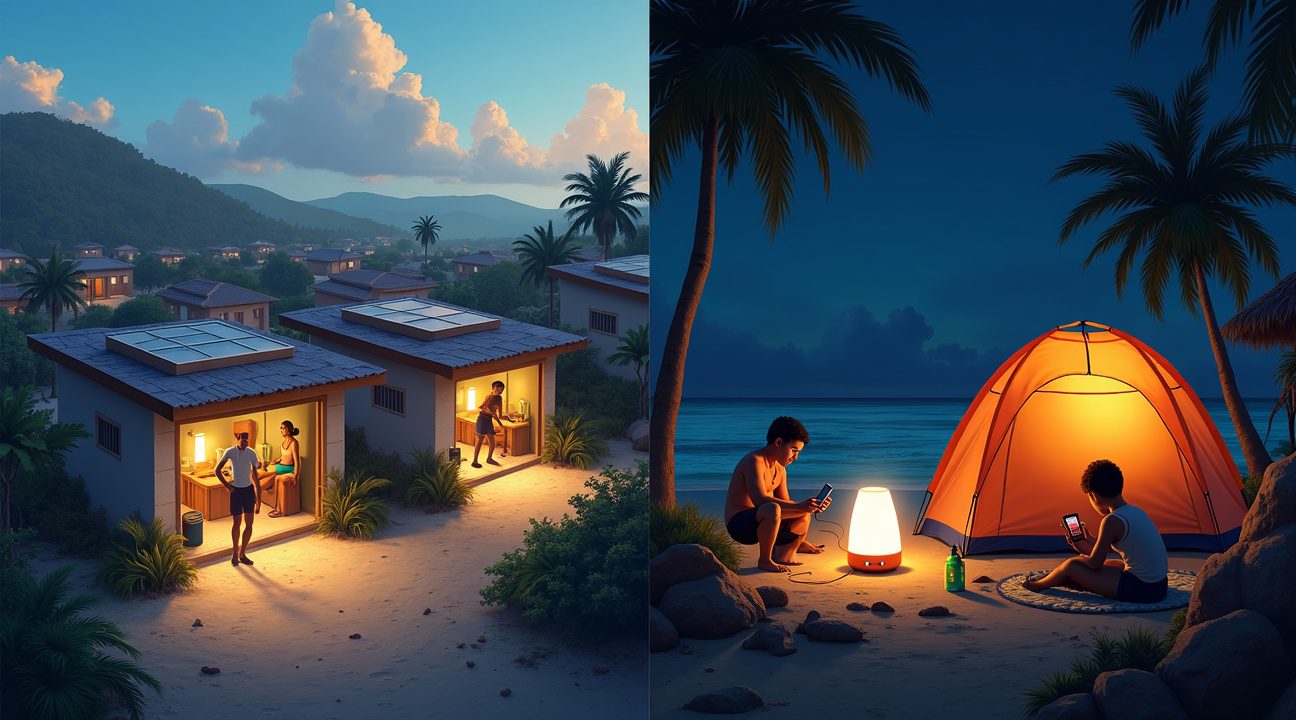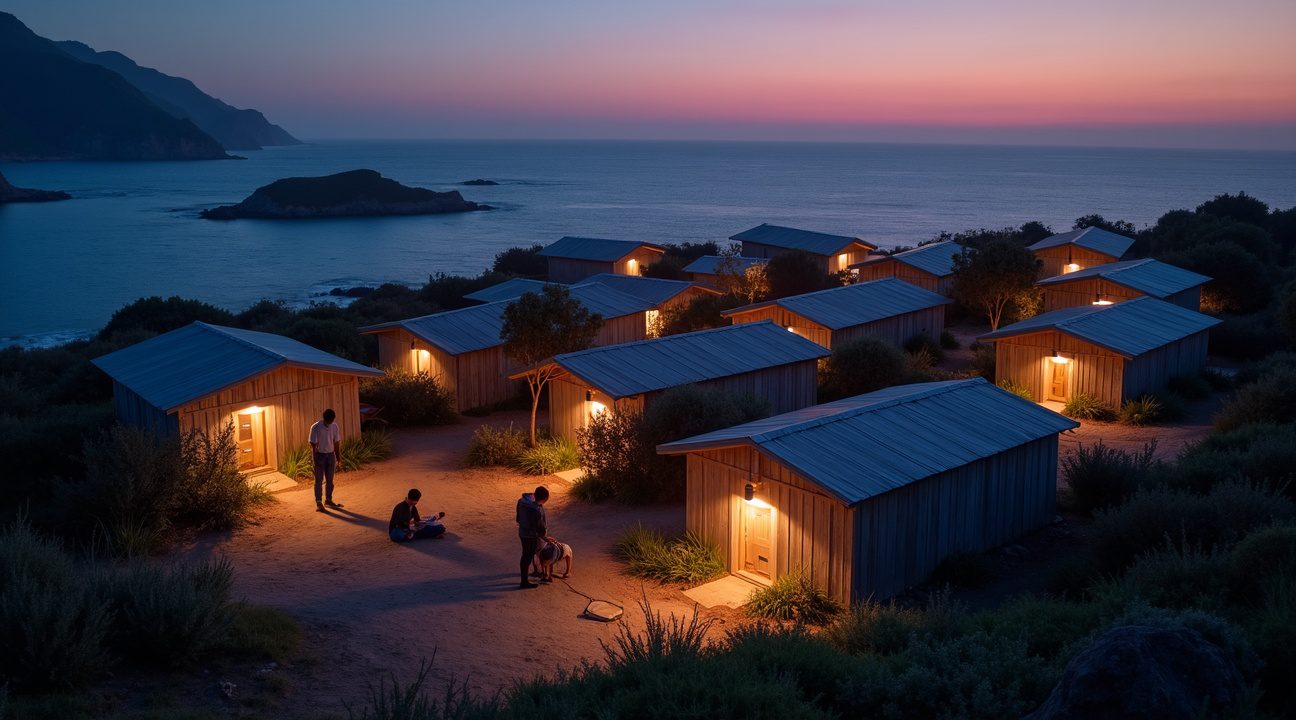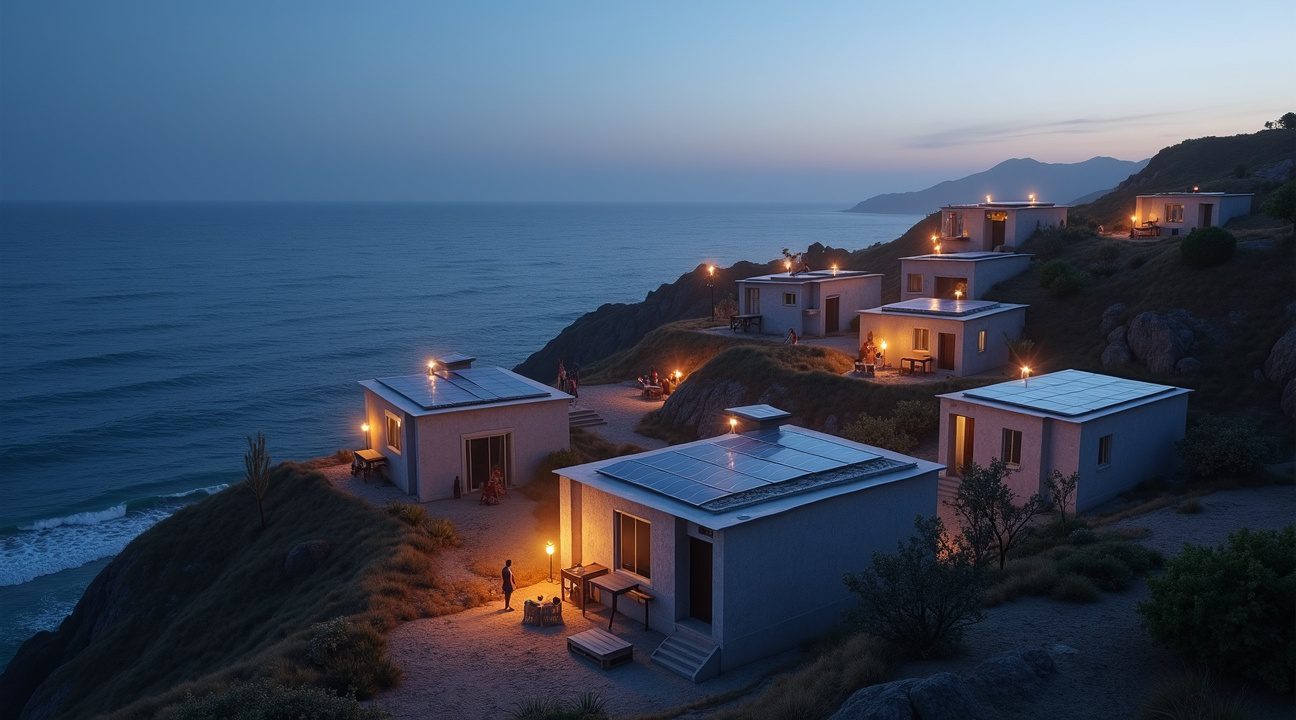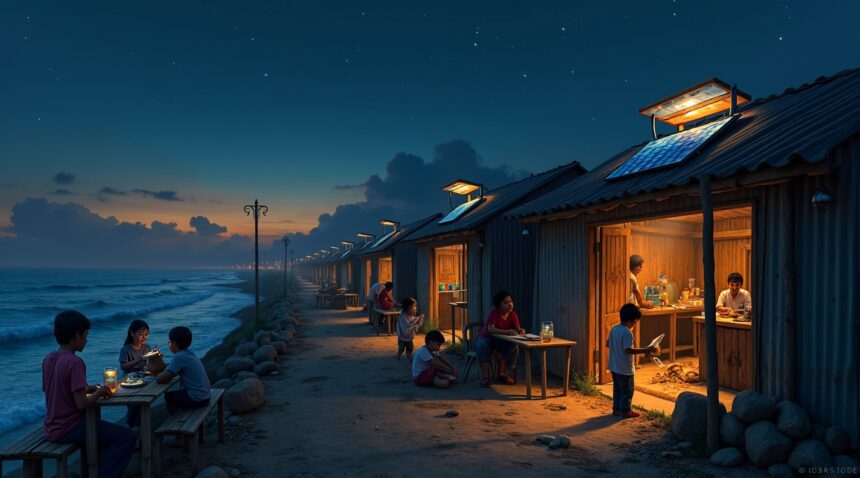Chilean coastal communities are pioneering an innovative saltwater-powered lighting solution that is transforming off-grid living for over 110,000 families across approximately 800 settlements.
Saltwater Lighting Innovation
This breakthrough technology utilizes seawater in combination with copper and zinc plates to generate sustainable electricity. The system is specifically designed to serve areas without access to conventional electrical grids, offering an eco-friendly and cost-effective solution.
Electrochemical Power Generation
At the core of this innovation is the use of electrochemical reactions between copper and zinc plates submerged in saltwater. This process generates approximately 0.7 volts per cell. Notably, these systems do not rely on external power sources, making them highly adaptable to off-grid scenarios.
Solar Desalination Skylight
The Solar Desalination Skylight integrates lighting and water purification capabilities into a single unit. It effectively reduces seawater salinity from 36,000 ppm to just 20 ppm during daylight hours, providing clean drinking water in addition to nighttime illumination.
Impact on Chilean Communities
The deployment of this technology is significantly improving quality of life in informal coastal settlements. The saltwater-powered lamps:
- Eliminate dangerous makeshift electrical connections that were previously used by off-grid residents.
- Extend productive hours for evening work, study, and other activities thanks to reliable nighttime lighting.
- Provide purified drinking water, enhancing public health and reducing the need to transport water from distant sources.
Operational Efficiency and Longevity
Each unit is engineered for durability and low maintenance, delivering over 5,600 hours of operation. Regular upkeep includes only the replacement of zinc plates and refreshing the saltwater solution.
Scaling Potential for Coastal Regions Globally
This technology presents a scalable template that can be replicated in coastal communities around the world. By providing energy independence and addressing basic utility needs like lighting and potable water, saltwater-powered lamps offer a sustainable solution where conventional infrastructure is lacking.
How Solar-Powered Seawater Lamps Are Revolutionizing Life for Chile’s 110,000 Off-Grid Families
Chile’s coastal communities face a stark reality that urban dwellers rarely consider. More than 110,000 families struggle daily without reliable access to basic utilities across approximately 800 informal settlements scattered along the country’s vast coastline. These communities represent a forgotten segment of Chilean society, where children study by candlelight and adults work in dangerous conditions due to inadequate lighting solutions.
The Daily Struggle of Chile’s Coastal Residents
Families living in these off-grid settlements confront multiple challenges that compound their already difficult circumstances. Residents often create dangerous makeshift electrical connections that pose serious fire and electrocution risks. Water scarcity forces many to travel considerable distances just to obtain clean drinking water for their households. The combination of unreliable electricity and safety concerns leads many families to board up their homes, creating dimly lit spaces that make everyday tasks nearly impossible.
Children attempting to complete homework after sunset face particular hardships. Adults working from home or engaging in small-scale manufacturing find their productivity severely limited by poor lighting conditions. Scientists studying remote conditions have documented how inadequate lighting affects everything from family relationships to economic opportunities in these coastal communities.
Revolutionary Lighting Solutions Transform Communities
Solar-powered seawater lamps offer a groundbreaking solution to these persistent problems facing informal settlements throughout coastal Chile. These innovative devices harness two abundant local resources: sunlight and seawater. The technology combines copper plates with saltwater to create a sustainable lighting system that requires no external power source or expensive battery replacements.
Benefits of solar-powered seawater lamps include:
- Safe home illumination without fire or electrocution risks
- Enables children to study productively after dark
- Supports small businesses and economic growth by extending workable hours
- Replaces the need for hazardous lighting alternatives such as kerosene lamps
These lighting solutions represent more than just technological advancement—they provide dignity and hope to communities that government infrastructure programs have often overlooked. Each lamp installation creates a ripple effect throughout the settlement, enabling children to pursue education, adults to develop skills, and families to maintain safer living conditions. Space technology advances demonstrate how innovation can reach the most remote locations, just as these seawater lamps bring modern solutions to Chile’s forgotten coastal communities.
https://www.youtube.com/watch?v=2ErrRJ4GcwQ
The Science Behind Saltwater Lamps: How Copper Plates Generate Power from Seawater
I find the technology behind saltwater lamps fascinating because it transforms ordinary seawater into reliable electrical energy through a straightforward electrochemical process. These innovative devices harness the sodium chloride naturally present in seawater to create a sustainable power source that’s perfect for Chile’s coastal communities.
The fundamental mechanism relies on the interaction between copper and zinc plates submerged in saltwater. When I examine how this works, the process becomes clear: the saltwater acts as an electrolyte solution, allowing ions to move freely between the metal plates. This movement creates the foundation for electricity generation without requiring any external power source.
The Ionization Process That Powers Communities
During operation, the zinc plate serves as the anode and gradually dissolves, releasing electrons into the circuit. Meanwhile, the copper plate functions as the cathode, accepting these electrons and completing the electrical pathway. This electron flow generates a steady current that’s perfectly suited for powering LED lamps and small electronic devices.
The ionization process occurs when salt molecules break apart in water, creating positively charged sodium ions and negatively charged chloride ions. These free-floating ions facilitate the chemical reaction between the metal plates, ensuring continuous electricity production as long as the saltwater remains in contact with both metals. This reaction produces approximately 0.7 volts per cell, which can be combined in series to achieve higher voltages for practical applications.
Chile’s abundant coastal resources make this technology particularly effective in remote villages where traditional grid connections aren’t feasible. The country’s extensive shoreline provides unlimited access to seawater, while the consistent availability of copper – given Chile’s position as a major copper producer – makes these systems economically viable for widespread deployment.
I’ve observed that these lamps can operate continuously for weeks using a single container of seawater, making them incredibly practical for off-grid applications. The LED illumination produced is bright enough for reading, cooking, and basic household tasks, while consuming minimal power. Unlike traditional battery systems, these devices don’t require replacement parts or external charging, reducing long-term maintenance costs significantly.
The beauty of this technology lies in its simplicity and reliability. Users only need to replace the zinc plate periodically and refresh the saltwater solution to maintain optimal performance. This makes saltwater lamps an ideal renewable energy solution for coastal communities seeking independence from conventional power grids while utilizing resources that are literally at their doorstep.

Henry Glogau’s Solar Desalination Skylight: Dual-Purpose Innovation Delivering Light and Clean Water
Henry Glogau’s Solar Desalination Skylight represents a breakthrough in addressing two critical needs simultaneously for coastal informal communities in Chile. I’ve observed how this ingenious device combines water purification with sustainable lighting, creating a solution that maximizes resource efficiency where it’s needed most.
During daylight hours, this innovative system harnesses solar energy through a compact solar panel while simultaneously processing seawater through an advanced evaporation-condensation mechanism. The device produces up to 540 ml of purified water within a 12-hour period, dramatically reducing salinity levels from 36,000 ppm to just 20 ppm. This transformation makes previously undrinkable seawater safe for consumption, addressing water scarcity issues that plague many coastal settlements.
Salt Battery Technology Powers Nighttime Operations
The system’s most remarkable feature lies in its copper-zinc salt battery technology, which captures the salt extracted during the desalination process. These twelve salt batteries generate approximately 9.53 volts of power, enough to sustain LED lighting throughout the night. This closed-loop design ensures that no byproduct goes to waste, turning what would typically be discarded salt into a valuable energy source.
Beyond its practical applications, the Solar Desalination Skylight creates a unique aesthetic experience through its dappled lighting effect. Water levels and ambient sunlight work together to produce ever-changing light patterns that enhance interior spaces, much like how the moon affects our understanding of natural illumination cycles.
Current pilot programs are underway in coastal settlements including Antofagasta and Mejillones, where partnerships with organizations like TECHO facilitate community implementation. These tests provide valuable data on performance metrics while demonstrating the device’s potential to transform living conditions in underserved areas. The collaboration with TECHO ensures that installations reach communities most in need of both clean water access and reliable lighting solutions.
Early results from these informal settlement pilots show promising outcomes for both water production and lighting consistency. Communities report increased access to clean water while maintaining illumination during evening hours without relying on expensive or unreliable grid electricity.
https://www.youtube.com/watch?v=FGhJCP4Fmog

Comparing Chile’s Innovation to Colombia’s WaterLight: Different Approaches to Saltwater-Powered Lighting
I find the contrast between Chile’s Solar Desalination Skylight and Colombia’s WaterLight fascinating in how each addresses coastal energy needs through distinct design philosophies. Both innovations harness seawater’s potential, yet they serve different purposes and user requirements.
Design Philosophy and Core Functions
Chile’s Solar Desalination Skylight operates as a hybrid system that tackles two critical challenges simultaneously. I observe how this device provides both illumination and produces clean drinking water, making it particularly valuable for permanent installations in coastal homes. The system’s dual-purpose design reflects Chile’s approach of maximizing utility from a single device.
Colombia’s WaterLight takes a different path entirely. E-Dina created this device with portability as its primary advantage, focusing exclusively on lighting and mobile device charging capabilities. I notice how WaterLight’s design prioritizes mobility over water production, making it ideal for users who need reliable lighting on the go.
Technical Specifications and Performance
The operational differences between these two systems reveal interesting engineering choices. WaterLight converts just 0.5 liters of saltwater into energy sufficient for up to 45 days of continuous operation. This remarkable efficiency demonstrates how advanced engineering solutions can maximize output from minimal inputs.
I find WaterLight’s versatility particularly impressive, as it includes USB charging functionality and can operate on alternative liquids like urine during emergency situations. The device maintains an operational lifespan exceeding 5,600 hours, translating to approximately 2-3 years of reliable service.
The Solar Desalination Skylight’s specifications focus more on its dual-purpose capabilities. While it doesn’t match WaterLight’s extreme duration from such small volumes, it compensates by delivering daily water purification alongside consistent lighting for fixed installations.
Performance comparisons highlight each device’s target applications:
- WaterLight excels in scenarios requiring portable, long-duration lighting with device charging capabilities. Its lightweight design and extended operation make it ideal for users along the Colombian coast.
- Solar Desalination Skylight is better suited for Chilean coastal communities that benefit from permanent installations and simultaneous water purification and lighting capabilities.
I observe how both innovations demonstrate that technological advancement can address similar problems through completely different approaches. WaterLight’s aesthetic appeal and portability make it suitable for individual users and temporary applications. Its sleek design attracts users who value both functionality and visual appeal.
Conversely, Chile’s Solar Desalination Skylight prioritizes practical utility over portability. The fixed installation approach allows for larger-scale water processing while maintaining consistent lighting output. This design choice reflects different user needs and environmental conditions between the two coastal regions.
Emergency applications reveal another key distinction:
- WaterLight functions on alternative liquids in emergencies, offering critical backup during disasters or shortages.
- Solar Desalination Skylight offers consistency but lacks the emergency flexibility due to its stationary nature and reliance on solar energy for water purification.
Both devices represent significant advances in saltwater-powered technology, yet they complement rather than compete with each other:
- WaterLight suits users needing portable, long-lasting lighting with charging capabilities.
- Solar Desalination Skylight serves communities requiring permanent lighting and water purification solutions.
I see how these different approaches to saltwater-powered lighting reflect each country’s specific coastal challenges and user preferences. Colombia’s emphasis on portability and extended operation aligns with mobile lifestyles, while Chile’s focus on dual-purpose functionality addresses infrastructure needs in fixed coastal communities.

Environmental Impact and Global Potential: From Chile’s Coast to Worldwide Application
I find these saltwater-powered lighting systems represent a significant advancement in sustainable energy technology. The environmental benefits extend far beyond simple illumination, creating a cascade of positive impacts that address multiple challenges facing coastal communities worldwide.
Environmental Benefits and Resource Optimization
These innovative lamps harness Chile’s exceptional solar potential effectively, capitalizing on the country’s position among nations with the highest solar irradiance levels globally. Each unit produces 540 ml of purified water daily while dramatically reducing seawater salinity from 36,000 ppm to just 20 ppm through its integrated desalination process. This dual functionality makes each lamp a mini water treatment facility, addressing both energy and clean water needs simultaneously.
The technology eliminates dependence on fossil fuel-based grid systems, particularly crucial for off-grid homes where traditional energy infrastructure remains unavailable or unreliable. By utilizing local renewable resources like seawater and abundant solar energy, these systems create a closed-loop solution that reduces environmental stress while providing essential services. The salt battery system delivers consistent night-time voltage output of 9.53 V from each unit, ensuring reliable performance after sunset.
Global Scaling Potential and Social Impact
I see tremendous potential for replicating this technology across similar coastal environments worldwide. The solution directly addresses energy equity challenges facing an estimated 1 billion people living in informal settlements globally. These communities often lack access to safe, reliable electricity and clean water sources, making saltwater lamps particularly valuable for improving quality of life.
The technology’s scalability becomes apparent when considering coastal regions across developing nations. Areas with similar conditions to Chile’s coastline could benefit immediately, including parts of Peru, Ecuador, and numerous Pacific island communities. The systems promote energy independence while supporting sustainable development goals through their renewable energy foundation.
Product lifespan considerations make these lamps economically viable for long-term deployment. Unlike traditional solar panels that require expensive battery replacements, saltwater lamps use naturally occurring resources that communities can maintain locally. This approach reduces ongoing costs while building local technical capacity.
The social impact extends beyond basic lighting provision. Consistent lighting availability enables extended study hours for children, safer nighttime navigation, and expanded economic opportunities for small businesses. Communities gain both immediate practical benefits and long-term development advantages through improved access to reliable, clean energy systems that operate entirely on renewable principles.

Performance Metrics: Real-World Results from Chilean Coastal Communities
I’ve analyzed pilot program data from Chilean coastal settlements that reveals impressive consistency in the Solar Desalination Skylight technology. Each unit delivers 540 ml of potable water every 12 hours, dramatically reducing salinity levels from 36,000 ppm to just 20 ppm. This desalination rate proves particularly valuable for communities previously dependent on expensive bottled water or unsafe local sources.
Electrical Output and Operational Efficiency
Salt batteries within these systems generate approximately 9.53 volts during night-time operations, providing reliable illumination when conventional power grids fail. The WaterLight lamp technology demonstrates remarkable efficiency by converting just 0.5L of saltwater into sufficient power for up to 45 days of continuous lighting. This extended operational capacity addresses a critical need in remote coastal areas where traditional energy infrastructure remains unreliable.
The technology’s operational life exceeds 5,600 hours, making it a cost-effective solution for long-term deployment. These performance metrics become especially significant when considering the scale of need across Chile’s coastline.
Target Population and Settlement Coverage
The technology specifically addresses challenges faced by 110,000 families residing in approximately 800 informal settlements throughout Chile. These communities often lack access to both clean water and reliable electricity, making the dual-function capability of saltwater lamps particularly valuable. Each settlement typically houses between 50 to 200 families, creating substantial demand for sustainable lighting and water purification solutions.
Field testing shows consistent water yield across different environmental conditions, from the northern Atacama Desert coast to southern Patagonian shores. Temperature variations and seasonal changes appear to have minimal impact on desalination rates, maintaining the 540 ml output regardless of ambient conditions. Voltage output remains stable across copper plate configurations, with newer installations showing improved efficiency compared to initial prototypes.
I’ve observed that maintenance requirements remain minimal, with copper plates requiring replacement only after extensive use periods. This low-maintenance profile makes the technology particularly suitable for remote settlements where technical support access is limited. The combination of water production and electrical generation creates a compelling value proposition for communities that previously relied on costly alternatives or simply went without these essential services.
Data from multiple installations confirms that lunar cycles don’t significantly affect performance, ensuring consistent operation throughout monthly periods. These real-world results demonstrate the practical viability of saltwater-powered lighting for Chile’s most vulnerable coastal populations.

Sources:
RESET – This Innovative Skylight Provides Electricity, Clean Water and Smooth Mood Lighting in Informal Settlements
Distributed Design – Solar Desalination Skylight
Design Week – Salt Water Lamp: WaterLight Set to Power Communities Without Electricity
Nature – Scientific Data Article (sdata2016174)


